Will Wimbledon Miss Its Best-Dressed Officials?

Will 'Sport's Best Dressed Officials' Be Missed at Wimbledon?
This year marks a significant shift in the history of Wimbledon, one of the most prestigious tennis tournaments in the world. For the first time in its 148-year history, there will be no line judges on the courts, as electronic line calling has taken center stage. While technology has advanced to enhance the game, many are left to wonder about the implications of this change. Will the absence of line judges, often considered "sport's best dressed officials," diminish the tournament's unique charm? In this article, we’ll explore the evolving role of line judges, the impact of technology on tennis, and the mixed feelings surrounding this historic change.
The Role of Line Judges in Tennis
Line judges have been an integral part of tennis for many years, acting as the eyes on the court to ensure fair play. They make split-second decisions on where the ball lands, often under immense pressure from players and spectators alike. The role requires sharp focus, quick reflexes, and a commanding presence, as their calls can determine the course of a match.
For many line judges, the allure of the role extends beyond the game itself. Thomas Sweeney, for instance, was initially drawn to line judging by the simple incentive of a free sandwich. Similarly, Pauline Eyre, who dedicated 16 years to the role at Wimbledon, cherished the opportunity to don the iconic blazers and the chance to purchase tickets for the tournament, even if it meant taking annual leave from her job.
The Experience of Being a Line Judge
The experience of being so close to the action, with a front-row seat to major matches, is unparalleled. Eyre fondly recalls moments like observing Jana Novotna's foot shaking during a Wimbledon final or feeling the tension as John McEnroe challenged a call. These personal experiences and the camaraderie among officials added a layer of personality to the tournament that many fans and players will miss.
The Iconic Uniforms
The uniforms worn by line judges have also contributed to their status as "the best dressed officials in all of sport." Malgorzata Grzyb, chair of the Association of British Tennis Officials (ABTO), remarked on the pride of walking onto the grass courts of Wimbledon dressed in attire that many consider the pinnacle of officiating fashion. The attire is not just about aesthetics; it embodies the rich traditions of Wimbledon and adds to the overall atmosphere of the event.
The Shift to Electronic Line Calling
As technology advances, the role of line judges has come under scrutiny. Electronic line calling systems, such as Hawk-Eye, have been introduced to improve accuracy and speed up the game. While this technology has been embraced at various tournaments, Wimbledon’s decision to eliminate line judges completely marks a departure from tradition.
Advantages of Electronic Line Calling
- Increased Accuracy: Electronic systems provide precise measurements of where the ball lands, reducing human error significantly.
- Faster Decision Making: The speed of electronic calls allows for quicker match progression, minimizing interruptions.
- Reduced Player Frustration: Players can challenge calls with confidence, knowing that technology is backing their claims.
Challenges of Electronic Systems
However, the move to electronic line calling is not without its challenges. The absence of line judges means that players will no longer have the opportunity to express their frustrations directly to human officials. Eyre recalls numerous instances of being "yelled at" by players, which, while stressful, added a layer of interaction that is now lost.
Furthermore, players like Novak Djokovic and Andrey Rublev have had heated moments with line judges, highlighting the emotional investment that players have in their calls. With technology, the human element of these interactions is removed, leading to a different dynamic on the court.
The Future of Line Judging
As the landscape of tennis evolves, so too does the future of line judging. While many line judges will find themselves without roles at major tournaments, around 80 will still be utilized as 'match assistants' at Wimbledon. They will assist in monitoring technology and escort players, thus maintaining a presence on the court, albeit in a diminished capacity.
Impact on Umpiring Quality
One concern raised by Eyre is the potential decline in the quality of umpiring as fewer individuals are trained in line judging. Historically, serving as a line judge has been a stepping stone to becoming a chair umpire. If aspiring officials no longer have opportunities to hone their skills in high-stakes environments like Wimbledon, it could eventually affect the overall quality of officiating at professional levels.
Technology vs. Tradition
The tension between technology and tradition in tennis is palpable. Traditionalists argue that the presence of line judges adds character and personality to the game, while advocates for technology emphasize efficiency and accuracy. As Paul Hawkins, the inventor of Hawk-Eye, stated, the excitement surrounding the challenge system has waned as fans have become accustomed to it. The question remains: can Wimbledon maintain its essence in a technology-driven environment?
The Role of the Chair Umpire
Despite the reduced number of officials on the court, chair umpires will continue to play a crucial role in overseeing matches. Sweeney, who has transitioned from line judge to chair umpire, believes that the human element in officiating is irreplaceable. While technology can offer precision, there are aspects of officiating that require empathy, understanding, and the ability to navigate complex emotional situations on the court.
The Emotional Landscape of Tennis
The emotional landscape of tennis is intricately tied to the human elements of officiating. With fewer officials on the court, the atmosphere may feel more solitary, as Sweeney notes. The tradition of sharing the experience with fellow officials, ball kids, and players has historically created a sense of camaraderie. While technology may streamline matches, it also risks diminishing the communal spirit that has characterized Wimbledon for generations.
The Voices Behind the Technology
Another fascinating aspect of this transition is the use of automated voices to call lines. The All England Club plans to employ different voices for various courts to prevent confusion. Eyre humorously suggested that having a recognizable voice, such as McEnroe’s, call the lines could add a playful touch to the experience. This creative approach could serve to bridge the gap between technology and the human touch that many fans yearn for.
Conclusion: A New Era for Wimbledon
The elimination of line judges at Wimbledon signifies a new era for the tournament, one that prioritizes technological advancement over tradition. While the benefits of accuracy and efficiency are undeniable, the loss of human interaction and tradition leaves many questioning the future of the sport. Will players, officials, and fans be able to adapt to this new norm, or will the essence of Wimbledon be forever altered?
As we look to the future of tennis, it’s essential to find a balance between embracing technology and preserving the unique characteristics that make tournaments like Wimbledon special. The voices of line judges, the iconic uniforms, and the human connections on the court will be missed, but perhaps the challenge lies in how the sport can evolve while still honoring its rich history.
FAQs
Will there be line judges at Wimbledon in the future?
As of now, Wimbledon has adopted electronic line calling and will not have traditional line judges. However, some line judges will still be present in supporting roles.
What are the advantages of electronic line calling over line judges?
Electronic line calling offers increased accuracy, faster decision-making, and reduced player frustration. Technology ensures a precise measurement of where the ball lands, minimizing human error.
How might the absence of line judges affect the quality of umpiring?
The absence of line judges may reduce opportunities for aspiring umpires to gain experience, potentially affecting the overall quality of officiating in the future.
As technology continues to reshape the world of sports, how will the balance between tradition and innovation play out in tennis? Will we find a way to honor the past while embracing the future? #Wimbledon #TennisTradition #ElectronicLineCalling
Published: 2025-06-25 05:50:29 | Category: sport



